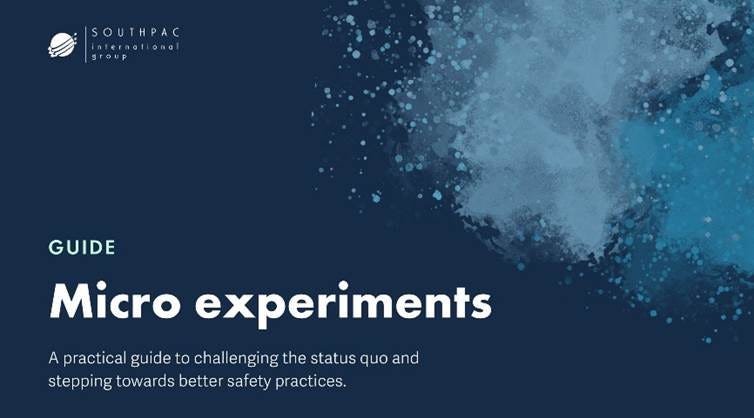82. Designing effective micro-experiments for your workplace
Small changes to workplace routines and rules can make big differences – and you don’t need permission to do them!
I have just downloaded a very interesting and useful short PDF about designing micro-experiments. As the guide says:
Micro experiments offer a practical, low-risk way to get started with the change you want to see. They allow you to test new ideas within your control, gather insights, and build momentum—without waiting for approval or large-scale resources. Instead of striving for perfect solutions, you can start small, learn quickly, and amplify what works.
The guide comes from Daniel Hummerdahl of Southpac International Group, a safety consultancy in Australia. They work in the aviation industry and other highly regulated sectors, and so have to do top-quality work. Their paradigm is based around ‘Safety II’, a relatively new approach which moves away from simple rule compliance and towards thinking about how good safety is created minute to minute and day to day as an active process. I’ve written about how this approach connects with Solutions Focus on my sfwork blog. These days it’s more often referred to as HOP – Human and Organisational Performance. Daniel works with the HOPLAB part of Southpac, developing and training safety professionals.
They’re also very keen on host leadership; I went over to Brisbane in 2018 to lead a three-day workshop and the organisation is still exploring how this way of leading sits well inside the Safety II approach prioritising engagement over compliance. Daniel was one of the speakers at our Host Leadership Gathering in Sydney in September 2024, and we’ve been continuing a conversation about new developments.
About the guide
The latest publication is called Micro experiments: A practical guide to challenging the status quo and stepping towards better safety practices. But that maybe undersells it – it’s a powerful way of working that will help in all kinds of settings, not just safety. It’s free to download from Southpac here. (They won’t even ask for your email address in exchange for the guide. That’s a total bargain.)
The guide is beautifully and clearly formatted and covers everything from why micro-experiments are valuable, when to use them, how they can work, how to design and execute them and how to analyse their success afterwards. It’s a real tour de force of bringing incisive clarity to working in messy real organisational life.
Working with emergence
One of the things I really like about the new guide is the way it connects so thoroughly with emergence and uncertainty. Daniel includes this diagram as part of showing how small experiments can be such an effective way to work, particularly in challenging situations where the stakes can be high.
This diagram is a superb way of showing how small changes and choices can help move things in a new direction – particularly when it’s an iterative process with multiple steps and adjustments.
A real-life case study
The guide links to a real-life example. Following a workshop with Southpac, a group of safety leaders tackled the challenge of transforming pre-start meetings in the construction industry. Their goal: to shift from static, top-down sessions to dynamic, worker-led discussions that better connect safety protocols with on-the-ground tasks.
The Challenge
Pre-start meetings often lack engagement, with workers passively listening as safety messages are delivered. Many safety professionals have become frustrated that these sessions are seen by frontline workers as box-ticking exercises – where meaningful dialogue is rare, and participation feels forced.
Ben Kirkbride, the Head of Health, Safety and Quality at Gamuda, recognised the need to address this disconnect with a format that would encourage active involvement, practical application, and immediate feedback.
The Solution
During the Safety Re-crafted workshop, Ben, along with safety peers Chris Iken and Paulo Gomez, reimagined the concept of pre-start meetings. Together, they designed a micro-experiment based on the ‘walk-through talk-through’ approach: a small but tangible shift that would take pre-start discussions from the meeting room into an actual work environment.
The next day, Ben tested the idea on-site. After the standard pre-start meeting, he guided the crew and supervisors into the work area, turning their safety talk into an interactive session. Workers demonstrated their tasks, highlighted challenges, and collaboratively discussed solutions.
Ben noted that the method’s success was rooted in its simplicity and the authenticity of the environment. By seeing the tasks in context, workers could provide richer, more detailed insights. The method fostered a sense of ownership among the crew and encouraged natural collaboration.
The Results
The trial yielded significant outcomes:
Engagement and Ownership: Workers, many of whom had little familiarity with Ben beforehand, quickly embraced the approach. They actively participated in discussions and contributed valuable insights.
Practical Problem-Solving: The hands-on nature of the walk-through revealed real-time decision-making processes and enabled the team to address challenges collaboratively.
Richer Dialogue: Unlike traditional meetings, the ‘walk-through talk-through’ method brought specificity to the conversation, with workers discussing detailed aspects of their tasks, safety measures, and operational hurdles.
Strategic Usage: A debrief with the crew highlighted that the approach was most valuable when applied less frequently, such as weekly or during high-risk or complex operations.
Lessons Learned
Through this micro-experiment, Ben and his team uncovered several key lessons:
Start Small: Begin with manageable steps to avoid overcomplication or resistance.
Adaptability: The ‘walk-through talk-through’ complements, rather than replaces, traditional pre-start meetings. It enhances existing practices rather than disrupting them.
Keep It Concise: Keeping sessions to around 20 minutes maintains focus and prevents complacency.
Engage Strategically: The approach is particularly valuable in environments with overlapping contractors or during transitions between phases of work.
(This is all taken from the Southpac blog at https://www.southpacinternational.com/news/re-crafting-pre-start-meetings-through-micro-experimentation/).
Final Tips
The guide ends with a short list of final tips which is valuable in itself:
By testing multiple ideas simultaneously, you can identify promising directions while minimising risks.
Small, actionable steps can inspire momentum and gradually build support for broader initiatives.
Gather data and stories from the micro experiment to build a case for wider engagement.
Keep it small, embrace iteration, and refine as you go.
Set a time limit or end date to remind yourself that you are not designing a perfect solution.
Have fun. The best fuel for a micro experiment is the energy you bring to it.
Conclusions
I do hope I have whetted your appetite for taking a look at the Micro Experiments Guide. There is so much valuable information, presented wonderfully clearly. And it’s not a long or wordy document – more like well-focused 19 slides. Ever since Paul Jackson and I included the Small Actions tool in the original edition of The Solutions Focus, I’ve been hoping to see work like this appear which really shows how well-chosen and well-executed small practical steps can both move things forward AND open new doors for other developments. This kind of thinking can be a key part of any humane and effective organisation.
Dates and mates
It’s time for this year’s SF24, the global festival of Solution Focus. It’s this coming Friday 2 May, worldwide. I can’t participate this year, but there will be a session about research and writing for the Journal of Solution Focused Practices from my colleague Andreea Zak at 8am CET.
Register free to access any and all of the online sessions at







Really useful, simple, actionable - tx for sharing, Mark. I know folks who wd benefit from this as they navigate 'fixed systems' that want to be 'transformational'. Messy org life, as you say.